CELESTRON C5 127mm Astronomy Spotting Scope with 45-degree, erect-image diagonal
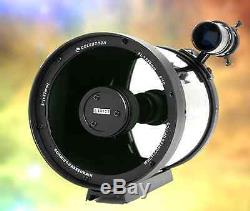
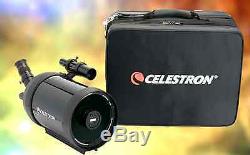
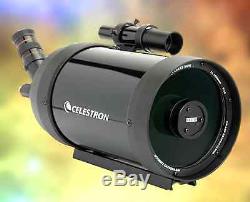
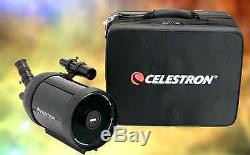
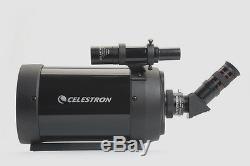
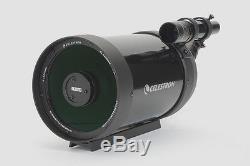
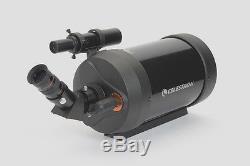
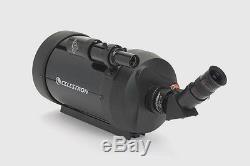

Celestron C5 127mm Astronomy Spotting Scope. Schmidt-Cassegrain optical system with 5 aperture. 25mm (50x) Plossl Eyepiece - 1.25. Celestron's C5 spotting scope has been a bestseller for decades. In fact, it performs so well that NASA chose it for several space shuttle missions in the 1990s!
Here on Earth this 5 (127mm) 1,250mm f/10 Schmidt-Cassegrain optical tube is a perfect choice for the outdoors or viewing outer space. The Celestron C5 127mm spotter really shines when used for astronomy, serious bird watching, nature observation, and long range surveillance. Weighing just 6 lb and measuring 11 in length, this scope is a completely portable visual and photographic instrument that performs well in any viewing location. Plus, you can expand its capabilities with a wide variety of optional accessories. With 5 of aperture, the C5 offers more light gathering ability than most other spotting scopes in its price range. Crisper, brighter, more detailed images. You'll get more than 4.5 times the light gathering ability of a 60mm spotting scope and nearly 2.5 times that of an 80mm scope, making the Celestron C5 the obvious choice when you need raw power and brilliant, sharp views. The C5 spotting scope is a wonderfully versatile instrument with a close focus of approximately 20 feet that allows you to observe nearby plant life and insects in larger-than-life detail. On the opposite end of the spectrum, when used as an astronomical telescope, the C5 can render spiraling galaxies and swirling nebulae millions of light years away. Get even more out of your C5 by attaching your DSLR camera.This scope is fully camera-adaptable. Just add an optional T-adapter and T-ring specific to your camera model, and you're ready to capture professional quality shots of birds, landscapes, wildlife, and more. The C5 comes in its own soft-sided carrying case.
A tripod adapter block on the C5's tube makes quick work of tripod mounting for viewing or photography. Field of View at 1000 Yards. Above: Optical layout of a typical Schmidt-Cassegrain. Schmidt-Cassegrains telescopes (SCTs) have become one of the most popular types of telescopes.
This is due to the versatility and compactness of the optical design. SCTs are only about twice as long as their aperture. They are also well-suited to a number of applications including photography and terrestrial observing as well as stargazing.
Most new SCTs are computerized, adding to their ease of use and portability. Schmidt-Cassegrain telescopes are a catadioptric.
Design, meaning they use both lenses and mirrors. Telescopes, but they use a corrector lens. To eliminate aberrations that would result from the mirror design alone. In an SCT the incoming light passes through the Schmidt corrector lens (also called a corrector plate) at the front of telescope. It is reflected from a concave primary mirror. At the back of the scope which focuses the light to the front of the telescope where it is reflected again by a smaller, convex secondary mirror. Finally, the light travels back through a hole in the primary mirror to the rear of the scope where an eyepiece is located for visual observing (or a camera for photographing). By folding the light in this manner, an SCT can be made much smaller than an equivalent Newtonian. At first it seems that an SCT should have a focal length. Twice as long as the length of the tube, since the light travels twice the length of the tube. However, SCTs actually have focal lengths about 5 times longer than the tube length. This is due to the convex curvature of the secondary mirror. This effectively magnifies the focal length, making the scope act much longer than it is. The diagram below shows how a Cassegrain type telescope (such as an SCT or similar design) works to increase the effective focal length. The primary mirror of an SCT usually has a focal length only about twice its diameter. For example, an 8" telescope would have a primary mirror focal length of about 16". This focuses the light to a point 16 in front of the mirror. By placing a convex secondary mirror between the primary mirror and this focal point, the light is reflected back toward the primary mirror but at a less steep angle.If you trace this light cone back to where it reaches the full width of the telescope's aperture. You can see how long the effective focal length is. Most SCTs have secondary mirrors that provide a 5x magnification factor. In this example that would make the effective focal length 80", or ten times the diameter of the primary mirror, in a telescope only about 16" long.
Above: How a Cassegrain telescope creates a long effective focal length in a short tube. The actual length of the telescope is barely longer than the separation between the two mirrors.
So what makes a Schmidt-Cassegrain different from a Maksutov-Cassegrain. Or just a plain old Cassegrain.The answer has to do with the corrector lens at the front of the scope. In an all-reflective Cassegrain telescope (usually called a Classical Cassegrain), there is no corrector lens. To eliminate aberrations, this type of telescope must have aspherical.
Mirrors, which are difficult and expensive to manufacture. By placing a corrector lens in front of the telescope, these aberrations can be minimized or eliminated while using spherical mirrors which are cheaper and easier to make. As the name implies, Schmidt-Cassegrains use a Schmidt corrector lens, while a Maksutov-Cassegrain uses a Maksutov corrector lens.
Schmidt corrector lenses have an aspherical shape. The curve on the lens is very slight, and the glass looks perfectly flat to the eye. The curve is drawn greatly exaggerated in the diagram at the top of the page. With both mirrors left spherical, an SCT suffers from coma. An aberration affecting sharpness of the stars at the edge of the field.By making the secondary mirror aspheric, coma can be eliminated. Meade's Advanced Ritchey-Chrétien telescopes are of this latter design, simulating the effect of true Ritchey-Chrétien.
Optics in an SCT configuration. Why are SCTs so popular? Most amateur astronomers enjoy many different aspects of our hobby, from observing planets to hunting for deep-sky. Objects to photographing the heavens.SCTs are good for all of these things. While certain telescopes might be better suited for one particular application, SCTs can do it all. Will provide more aperture and hence be better for deep-sky observing, but it cannot be used for photography.
A high-quality refractor can give some of the best planetary views of any type of telescope, but a large-aperture refractor capable of competing with an 8" or 10" SCT in light-gathering ability is a huge, painfully expensive telescope. SCTs combine a compact telescope with good moderate-aperture optics which are well-suited to visual observing and imaging.There is nothing that can replace the extreme close-up view of a rare bird in the wild. Binoculars can get you close but, if you want to look the bird in the eye or confirm that identification for your life list, you need a spotting scope. Spotting scopes pack incredible magnification in a generally simple and lightweight package that is durable enough for field work while boasting fantastic optical quality for birding. In this second part of a four-part series on birding optics, we will discuss birding through the powerful magnification of the spotting scope. According to the US Fish and Wildlife Service (USFWS), as of 2011, more than 47,000,000 Americans are birders.
Birding ranks as the 15. Most popular outdoor recreational activity in the US. Chances are that you either know a birder or you see one when you look in the mirror. B&H Photo is a great place for stocking up on the best birding optics available, or for shopping for your favorite birder. The binocular is the traditional heart of the birders optical kit. However, the popularity of the spotting scope is growing for birders who are serious about getting closer to the action. At first glance, the spotting scope may look like a telescope, but it is more closely related to a monocular due to its image-erecting prism system. It delivers larger magnification capabilities to birders than all but the most powerful binoculars, and many spotting scope eyepieces can produce magnifications of up to 60x or higher. While some telescopes can be used to make terrestrial observations with the addition of specialized accessories, most will have optics and coatings specially designed for celestial viewing, so the viewing experience has the potential to be slightly offespecially where colors and resolution are concerned. The spotting scopeits optics, optical coatings, and housingis designed, from the start, to be a terrestrial viewing instrument. This does not mean that you cannot admire the moon, stars, or planets with a spotting scope; it just may not present an image quite as good as a purpose-built celestial scope. 40-year birder and Director of Conservation and Community at the American Birding Association Bill Stewart says, A good spotting scope will change your birding forever. Using a spotting scope, he says, is better for detailed observation and is the fastest way to advance your birding.Details are the key for Walker Golder, Deputy Director of Audubon North Carolina, who uses the offices Swarovski, Vortex, Kowa, and Nikon spotting scopes to read bands on tiny shore birds and terns. These coastal birds may only be three or four inches tall, and the leg bands, placed on the birds tarsus, might measure only half an inch. All that magnification means that handholding the device is nearly impossible, so taking a spotting scope into the field means taking a tripod and tripod head (or alternative support) into the field with youa big consideration when it comes to how far from home, or your vehicle, you will be setting up.
Also, binoculars may be lifted a few inches from your chest to your face for a quick observation. The spotting scope needs to be set up. Spotting scopes are not often very heavy and, therefore, do not require large tripods. But, you do want to get a tripod that reaches a comfortable height for extended viewing while being heavy enough to provide needed stability for your scope. For birding, a fluid tripod head, popular for use with video cameras, works fantastically with a birding scope.
When asked for spotting scope advice for beginning birders, Patrick Comins, Director of Bird Conservation at the Audubon Societys Connecticut office, and President of the Friends of the Silvio O. Conte National Fish and Wildlife Refuge, says simply, Get a good tripod. Spotting scopes come in two general configurationsstraight viewing and angled viewing. The difference is at the rear of the scope, where the erecting prism directs the light path straight in line with the body, or at an angle, typically 45 degrees, to the body.
In general, users, especially beginner birders, find it is easier to acquire and track birds with a straight scope, but the angled scope offers more viewing comfort. Chris Wood, experienced birder and Project Leader at Cornell Lab of Ornithologys eBird program, spoke to us about considerations when choosing one configuration over another: Passion can abound on the question of straight versus angled scopes. The best reason for straight is usually that its more intuitive to find the bird.
If you bird from your car and want to use a scope, straight scopes are also easier to use. If you are birding with others, you almost certainly want to use an angled scope, which makes it much easier for people of different heights to use the same scope. The other advantage is that you dont need to raise the scope as high, which means that the wind isnt as likely to shake the scope. In most cases, people are more pleased with an angled scope after a week or two of use. It may take a little longer to get started, particularly if you have used a straight scope for your entire life.
But your short friends will thank you. The item "CELESTRON C5 127mm Astronomy Spotting Scope with 45-degree, erect-image diagonal" is in sale since Friday, May 27, 2016. This item is in the category "Sporting Goods\Hunting\Scopes, Optics & Lasers\Spotting Scopes". The seller is "bluequasar17" and is located in Pewaukee, Wisconsin.
This item can be shipped worldwide.
- Type: Spotting Scope
- Brand: Celestron
- MPN: 52291
- Max Magnification: 50x
- Body Type: Angled
- Coating: StarBright coatings
- Use: Astronomy

